In the dynamic electronics sector, passive components such as capacitors, resistors, and inductors are crucial, functioning quietly yet effectively behind the scenes. These components operate without the need for an external power source and are fundamental in controlling energy flow and maintaining signal clarity within electronic circuits. A recent market report highlights that the global market for passive electronic components achieved revenues of USD 44.1 billion in 2023. Its growth rate is projected to be 6.5% annually.
This expansion is fueled by increasing requirements from sectors including automotive, telecommunications, and consumer electronics, which depend extensively on these components for innovative solutions. Exploring the technical and environmental implications of these components reveals their vital role in not just supporting but actively driving forward technological progress.
The Influence of Miniaturization on Passive Components
The push for miniaturization is transforming the electronics industry, leading to devices that are not only smaller and more powerful but also more cohesive, which requires adaptations in component design and usage. This shift is prominently seen in the evolution of compact passive components, such as variable inductors, essential in environments where space is limited. A variable inductor allows the adjustment of frequencies, providing exact performance in communication devices, medical instruments, and RF technologies.
These components integrate flawlessly into contemporary devices, from smartphones to wearable tech, enhancing capabilities without enlarging the device’s size. Such innovations are crucial to the expanding market of interconnected devices, thereby accelerating the trend toward miniaturization.
Enhanced Material Science Driving Innovation
Breakthroughs in material science have laid the groundwork for the next generation of more effective passive components. Using cutting-edge materials, researchers and engineers have managed to produce components that are not only more compact but also excel at handling higher temperatures and boast enhanced reliability. For instance, advancements in ceramic and polymer technologies have produced capacitors that maintain charge stability across diverse environmental conditions.
Additionally, exploration into materials like graphene is showing promise due to its superior conductivity and robustness, setting the stage for transformative improvements in the performance of resistors and inductors. These enhancements are crucial for the robustness and operational efficiency of both consumer and industrial electronics. As these technologies continue to advance, they are poised to facilitate the development of devices that deliver consistent performance in rigorous environments, such as those encountered in the aerospace and defense sectors.
Passive Components Driving Sustainable Electronics
Electronic industries face increasing pressure to reduce their environmental impact, with passive components playing an essential role in this transformation towards more eco-friendly technology. These components significantly enhance energy efficiency and reduce heat production, thus increasing energy savings while simultaneously prolonging device functionality and decreasing waste creation as well as the need for frequent replacements.
Passive components play an invaluable role in developing green power systems such as solar inverters and wind turbines, helping regulate fluctuating energy sources. Furthermore, recent advances in passive component technology have made possible devices that convert ambient energy directly into electrical power, further advancing the sustainability of electronic devices. This feature supports worldwide efforts to move away from fossil fuels, boosting the environmental merits of passive components.
The Crucial Role of Passive Components in Smart Technology
Passive components are vital to the expansion of smart technology across various sectors, from residential automation to industrial Internet of Things (IoT). These components are essential for regulating power consumption and preserving the integrity of communication signals. In devices such as smart thermostats or lighting systems, precision resistors, and inductors play a key role in ensuring stable operation despite fluctuating electrical loads, thus improving both efficiency and responsiveness.
With the growing implementation of smart city infrastructure, passive components are indispensable in developing networks that efficiently link transportation, utilities, and communications systems, enhancing the synergy and sustainability of urban environments. These components are also critical in edge computing devices, enabling faster data processing with minimal energy consumption.
Advances in Passive Component Manufacturing Techniques
Recent progress in the manufacturing technologies for passive components has significantly improved. Innovations such as 3D printing and automated assembly have accelerated production times, slashed costs, and enhanced the precision of creating passive components. These methods support the development of bespoke passive components designed for specific needs, boosting their adaptability across various sectors. Such progress supports more intricate designs and better integration into electronic systems, enabling the widespread production of superior passive components at reduced expenses. Additionally, manufacturers are increasingly adopting eco-friendly practices in these processes, like utilizing recycled materials and minimizing waste, thus aligning their operations with environmental objectives.
The Future Prospects: Predictive Analytics and AI
Looking forward, the fusion of artificial intelligence (AI) and predictive analytics with passive components promises to transform the electronics sector. Utilizing AI, manufacturers and designers can now forecast the lifespan and functionality of passive components with higher precision, enhancing the reliability and efficiency of electronic systems.
Predictive maintenance, driven by AI algorithms, is poised to significantly cut downtime and lower maintenance expenses in industrial settings, capitalizing on the inherent stability and dependability of passive components.
Additionally, AI-driven design tools are facilitating the generation of optimized layouts for passive components, ensuring optimal performance with minimal resource use. The collaboration between AI and passive components is expected to continue propelling innovation and operational efficiency across various industries.
Conclusion
Passive components significantly exceed their basic role as mere elements within electronic circuits. They are central to the ongoing revolution in electronics, driving advances in miniaturization, material science, manufacturing processes, and smart technology integration. Their role extends beyond traditional applications, marking their importance in future technologies such as quantum computing and energy-independent devices. As we continue to explore the potential of these components, their role in shaping the future of technology becomes increasingly clear. Stay tuned as we uncover more exciting developments in this crucial area of electronics.


